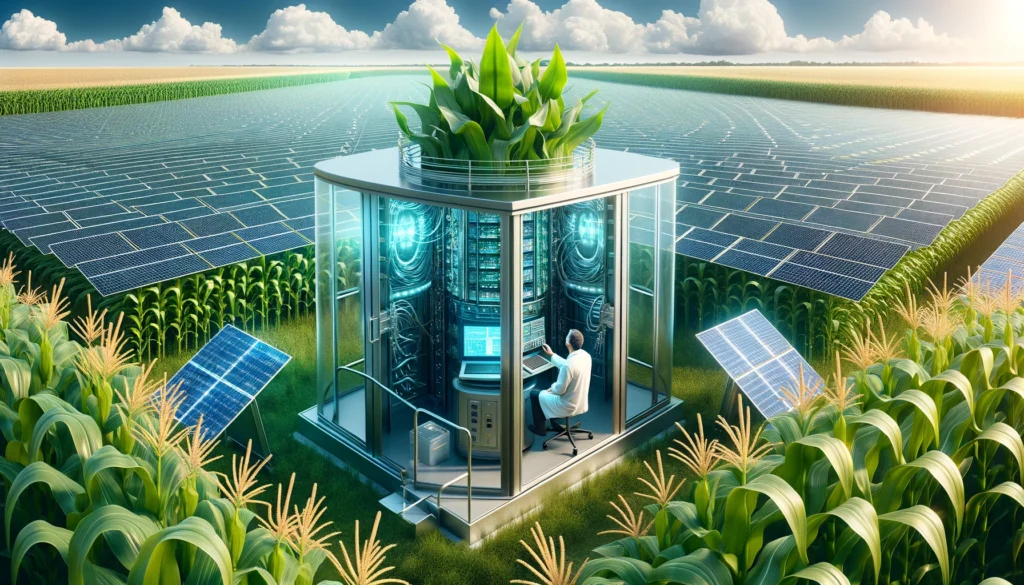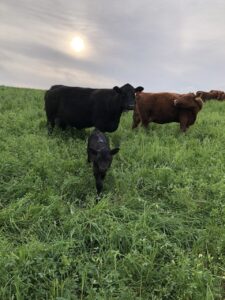
Crop Modeling 00.26 A wide aspect imaginative illustration depicting a supercomputer set up in the middle of a Nebraska corn crop. The supercomputer i7.webp.webp
Crop Modeling
Definition:
Crop modeling, also known as crop simulation modeling or agricultural systems modeling, is an interdisciplinary approach that integrates mathematical, statistical, and computational techniques to simulate and predict the growth, development, yield, and environmental interactions of crops within agroecosystems.
Insightful Analysis:
Crop modeling provides a powerful tool for understanding the complex interactions between crops, soils, weather, and management practices, enabling farmers, researchers, and policymakers to assess the impacts of different agronomic scenarios, climate change scenarios, and technology interventions on crop productivity, resource use efficiency, and environmental sustainability.
Fall off the barn roof and busted your keister? Life on the farm or ranch can be tough on the bum. Need a break? Laugh it off at FarmerCowboy.com, the #1 farm humor site. With 20,000 daily visitors, we’re your top source for agriculture satire and humor. Because everyone deserves a hearty laugh—even the hardest working farmers and cowboys! Join us and turn those long days into fun tales at FarmerCowboy.com.
Guidance for Application:
1. Model Development: Explore the principles and methodologies of crop modeling, including process-based models, empirical models, statistical models, and machine learning algorithms, for representing key biological processes, environmental drivers, and management practices affecting crop growth and yield.
2. Input Data Requirements: Collect and analyze input data sets, including weather data, soil data, crop management practices, and genetic parameters, to calibrate and validate crop models and generate accurate predictions of crop performance under different growing conditions and management scenarios.
3. Model Calibration: Calibrate crop models using historical field data, experimental trials, remote sensing observations, and sensor-based measurements to optimize model parameters, coefficients, and algorithms for specific crops, locations, and cropping systems.
4. Model Validation: Validate crop models using independent data sets, field observations, on-farm trials, and experimental studies to assess model accuracy, reliability, and robustness in simulating crop growth, development, yield, and responses to environmental variability and management practices.
5. Scenario Analysis: Conduct scenario analysis and sensitivity analysis using crop models to evaluate the impacts of different climate scenarios, management practices, technological innovations, and policy interventions on crop productivity, resource use efficiency, profitability, and resilience to climate change and other stressors.
6. Decision Support Systems: Integrate crop models into decision support systems (DSS) and precision agriculture tools to provide farmers with real-time recommendations, decision-making support, and risk assessments for optimizing crop management practices, input use, and resource allocation in response to dynamic environmental conditions and market dynamics.
7. Stakeholder Engagement: Engage stakeholders, including farmers, agricultural advisors, policymakers, researchers, and extension specialists, in participatory modeling processes, collaborative research projects, and knowledge sharing initiatives to co-develop, validate, and disseminate crop models and decision support tools that meet the needs and priorities of end-users.
Practical Recommendations for Farmers:
- Explore available crop modeling tools, software platforms, and online resources for accessing weather data, soil information, crop models, and decision support systems tailored to your crops, growing conditions, and management objectives.
- Participate in training workshops, webinars, and capacity-building programs to enhance your skills and knowledge in crop modeling, data analysis, and decision support tools, enabling you to make more informed and strategic decisions for managing your crops and optimizing farm performance.
- Collaborate with agricultural researchers, extension specialists, and crop advisors to apply crop modeling techniques and tools to address specific challenges and opportunities in your farming operation, such as optimizing irrigation scheduling, predicting pest outbreaks, and evaluating the economic feasibility of new technologies or practices.
In summary, crop modeling offers a valuable framework for simulating and predicting crop growth, yield, and environmental interactions, enabling stakeholders to explore alternative scenarios, optimize management practices, and enhance agricultural sustainability and resilience in a changing climate and global food system.
Realistic Benefits and Lessons from Crop Simulations and Modeling
Crop simulations and modeling offer a range of practical benefits and valuable lessons for agricultural stakeholders, researchers, policymakers, and farmers alike. Here are some realistic benefits and lessons we can learn from these tools:
1. Enhanced Decision-Making:
- Benefit: Crop models provide farmers with valuable insights and predictive capabilities for optimizing their management decisions, such as planting dates, crop varieties, irrigation scheduling, and fertilizer application rates.
- Lesson: By utilizing crop simulations, farmers can make more informed and data-driven decisions, leading to improved resource use efficiency, increased yields, and better economic returns on their investments.
2. Risk Management:
- Benefit: Crop modeling enables farmers to assess and mitigate risks associated with climate variability, extreme weather events, pest outbreaks, and market fluctuations by simulating different scenarios and adapting their management practices accordingly.
- Lesson: By incorporating risk management strategies based on crop simulations, farmers can reduce their vulnerability to environmental and market uncertainties, minimize production losses, and maintain farm resilience and sustainability over time.
3. Sustainable Intensification:
- Benefit: Crop models help optimize the intensification of agricultural production while minimizing negative environmental impacts, such as soil erosion, nutrient runoff, and greenhouse gas emissions, by simulating the effects of different management practices on soil health, water quality, and ecosystem services.
- Lesson: Through sustainable intensification approaches guided by crop modeling, farmers can achieve higher yields and profitability while safeguarding natural resources, conserving biodiversity, and preserving the long-term productivity and resilience of their farming systems.
4. Adaptation to Climate Change:
- Benefit: Crop simulations assist farmers in adapting to climate change by identifying suitable crop varieties, planting strategies, and agronomic practices that are resilient to changing environmental conditions, such as shifting temperature regimes, altered precipitation patterns, and increased frequency of extreme weather events.
- Lesson: By using crop modeling to anticipate and prepare for climate-related challenges, farmers can proactively adjust their farming practices, diversify their crops, and invest in climate-resilient technologies and infrastructure, thereby reducing their vulnerability and enhancing their adaptive capacity in a changing climate.
- Benefit: Crop models support the implementation of precision agriculture techniques, such as variable rate application of inputs (e.g., fertilizers, pesticides), site-specific management practices, and remote sensing technologies, by providing spatially explicit information on crop growth, soil fertility, and yield potential.
- Lesson: Through precision agriculture strategies guided by crop simulations, farmers can optimize input use efficiency, reduce production costs, minimize environmental impacts, and tailor their management interventions to the specific needs and conditions of individual field units, leading to more sustainable and profitable farming operations.
6. Innovation and Research:
- Benefit: Crop modeling serves as a valuable tool for agricultural research, innovation, and technology development, facilitating the testing of hypotheses, the exploration of alternative scenarios, and the generation of new knowledge on crop physiology, genetics, and management.
- Lesson: By leveraging crop simulations for research and innovation, scientists, breeders, and extension specialists can advance our understanding of crop-environment interactions, develop improved crop varieties and management practices, and address emerging challenges and opportunities in agriculture, contributing to food security, environmental sustainability, and rural development.
In conclusion, crop simulations and modeling offer practical benefits and important lessons for improving agricultural productivity, sustainability, and resilience in a rapidly changing world. By harnessing the power of these tools, farmers and stakeholders can make more informed decisions, manage risks effectively, adapt to climate change, enhance resource use efficiency, and foster innovation and research in agriculture.
References:
- Jones, J. W., Hoogenboom, G., Porter, C. H., Boote, K. J., Batchelor, W. D., Hunt, L. A., … & Wilkens, P. W. (2003). The DSSAT cropping system model. European Journal of Agronomy, 18(3-4), 235-265.
- White, J. W., Hoogenboom, G., & Stackhouse Jr, P. W. (2013). Evaluation of the uncertainty in daily high-resolution simulations of maize yield. Agricultural and Forest Meteorology, 170, 214-227.
- Rosenzweig, C., Elliott, J., Deryng, D., Ruane, A. C., Müller, C., Arneth, A., … & Jones, J. W. (2014). Assessing agricultural risks of climate change in the 21st century in a global gridded crop model intercomparison. Proceedings of the National Academy of Sciences, 111(9), 3268-3273.



Originally posted 2011-06-06 03:36:31.
Originally posted 2024-06-21 16:00:38.
Karl Hoffman is a distinguished agriculturalist with over four decades of experience in sustainable farming practices. He holds a Ph.D. in Agronomy from Cornell University and has made significant contributions as a professor at Iowa State University. Hoffman’s groundbreaking research on integrated pest management and soil health has revolutionized modern agriculture. As a respected farm journalist, his column “Field Notes with Karl Hoffman” and his blog “The Modern Farmer” provide insightful, practical advice to a global audience. Hoffman’s work with the USDA and the United Nations FAO has enhanced food security worldwide. His awards include the USDA’s Distinguished Service Award and the World Food Prize, reflecting his profound impact on agriculture and sustainability.



